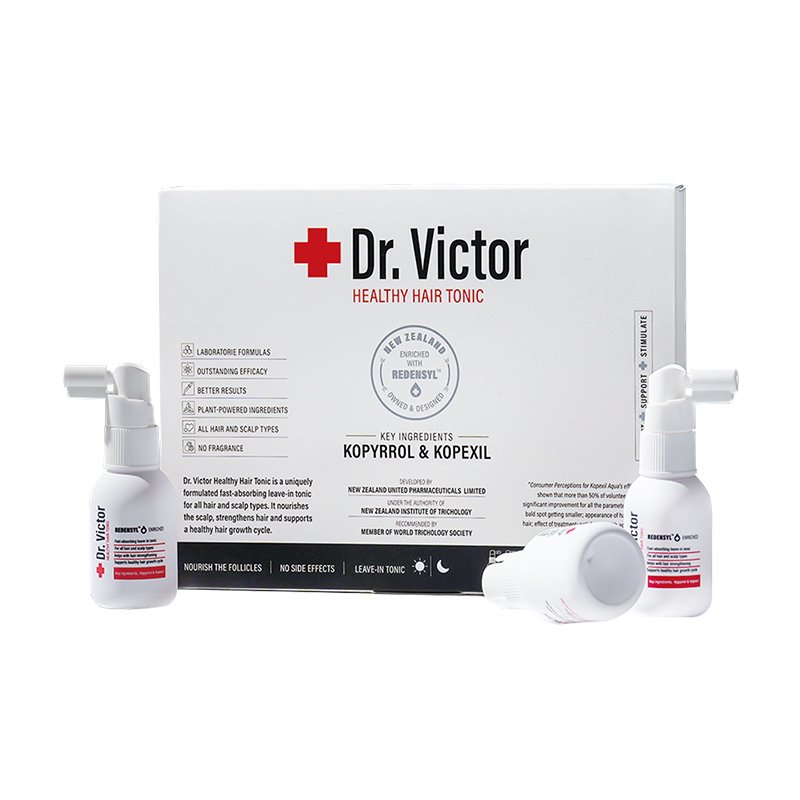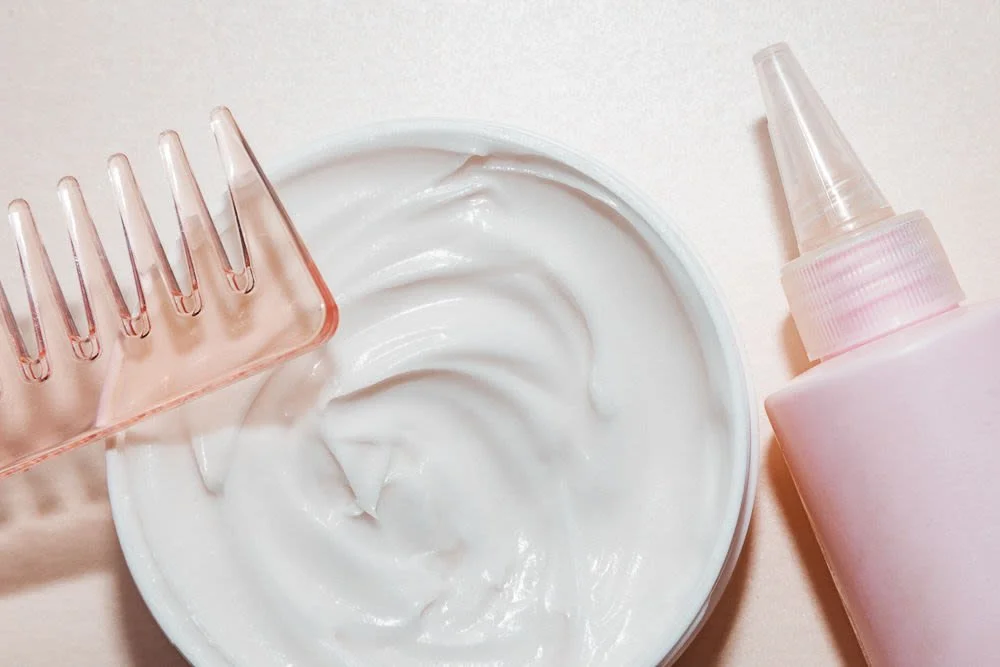Age-related changes are inevitable; in the same way our body changes, so does our hair. However, if you’ve gone from shedding a few strands each day to problematic hair loss, this new technology could help. Editor Trudi Brewer shares ‘follicle gene repair’ in a collection of easy-to-use hair care products by Dr. Victor. Read on to find out how they work.
Trichologist Chelcey Salinger with Dr. Victor haircare
Hair loss impacts almost half of all women at some stage of life. From periods of high stress to hormones in pregnancy, menopause or simply genetics, there are many reasons our hair can go from thick and lustrous to thin and lifeless. The good news is that you can improve this dilemma with treatments, routines, and lifestyle tweaks. But before we unpack hair loss, let’s get to the root of how hair grows. Each hair on your head goes through a growing and shedding cycle. There are four phases: anagen, catagen, telogen, and exogen. Anagen is the growth phase when hair is active and in production at the root. Catagen is a short phase in the hair growth cycle that usually lasts 10 to 20 days. At this time, the hair follicles shrink, and hair growth slows. Next comes telogen, the resting phase of the hair follicle; this is when hair naturally sheds, lasting three months. Finally, exogen is when the hair sheds from the scalp, and we can lose between 50 and 100 hairs every day - which is entirely normal. New hairs grow in the follicles as old hairs shed at this last stage.
So, to Dr. Victor, the latest innovation is a new range of hair-stimulating tonic and care products. Auckland-based registered cosmetic nurse Michelle Ordner shares advice on hair loss. “Genetic factors, as does hormonal imbalance, play a significant role in hair loss. Particular fluctuations in key hormones can contribute to hair thinning and loss, as well as environmental factors and lifestyle choices, including pollution, stress, and dietary habits.” The Dr. Victor range of haircare has got Ordner excited, especially the technology known as gene repair, which stimulates hair growth. “Follicle gene repair technology addresses issues at the genetic level within the hair follicles, targeting and repairing specific genes associated with hair loss. The goal is to promote the regeneration and revitalise hair follicles, preventing further hair loss and encouraging the growth of healthier, stronger hair.” With dozens of hair loss preparations on the market, Ordner believes Dr. Victor’s gene therapy, or as the brand refers to it, GeneRevive technology, is unique. “Traditional methods often focus on surface-level treatments or general hair health. Follicle gene repair technology goes straight to the source, the genetic makeup of the hair follicles. By identifying and rectifying specific genetic factors contributing to hair loss, this technology aims to provide more targeted and effective solutions rather than a one-size-fits-all approach.” So, how does it work for thin hair? “It targets certain genes responsible for weakened hair follicles or increased susceptibility to hair loss to correct or compensate for these genetic factors. This could result in improved hair follicle health, reduced hair shedding, and the restoration of a fuller, healthier head of hair.” As far as results go, Ordner is impressed, “Most people see results in three months, depending on lifestyle habits which can affect results, but the consensus from those using it aligns with this timeframe.”
What's in the formulation?
Trichologist Chelcey Salinger, who specialises in hair loss and scalp conditions daily from her Sydney-based clinic, is also a science advisor for the Dr. Victor formulas. Here, she shares the ingredients that can help with hair loss.
What anti-hair loss ingredients have you selected and why?
There are two main hair-stimulating ingredients. Kopyrrol promotes the proliferation of dermal papillae cells (at the bottom of hair follicles that play a role in hair formation and growth) and aids hair volume in the growth stage. While Kopexil can slow the ageing process within the hair root, delaying age-related hair loss. It can also help anchor the hair in the follicle. Also, in the formula, Redensyl contains plant compounds that target specific stem cells and fibroblasts within the hair follicle to improve hair growth and reduce hair loss. Minoxidil (which can be applied topically or taken orally) is a vasodilator that increases hair growth factors, while the addition of exosomes carries protein to the follicle to benefit the hair growth cycle. At the same time, caffeine blocks some conversion to DHT while stimulating hair follicle growth by prolonging the anagen phase (the growing phase of the hair cycle). The palm extract Saw Palmetto reduces the conversion of testosterone to DHT and promotes hair follicle vascularization. Finally, antioxidants like vitamin D and camelia extract help with hair health and shine.
Why does hair loss occur in women?
There are many types of hair loss, and their underlying causes differ. Some types of hair loss are autoimmune in nature, such as alopecia areata, lichen planopilaris (an uncommon inflammatory condition where smooth white patches on the scalp that can lead to permanent hair loss), and frontal fibrosing alopecia (uniform bands of hair loss along the front and sides of the scalp). The type of hair loss called telogen effluvium (diffuse hair loss) can be caused by a body imbalance, nutritional deficiency or extreme stress. I also see many women with pattern hair loss (genetic thinning). Men are more likely to experience pattern hair loss earlier and more severely. Women tend to maintain their frontal hairline and be thin behind it (noticing a widening of their part), whereas men will often first notice thinning at the temples and the crown. People with pattern hair loss will also experience miniaturisation. This means that, over a long period, the hairs become finer and finer, and the hair follicle itself (the follicle is the cup in the skin containing the hair’s DNA and holding the hair) becomes smaller and decreases in its depth into the skin. Eventually, the hairs become so fine they are negligible, and the final stage of this hair loss is the complete loss of the hair and its follicle. Once this has occurred, hair will never grow in that place again.
What ages are most affected?
Hair loss can occur at any age, but in my clinic, I see many women in their 20s and 30s who experience hair loss due to nutritional deficiencies. I also see many women who experience pattern hair loss, particularly as they go through menopause.
What is your best hair tip to help prevent hair loss?
Noticing hair loss early and seeking help from a certified trichologist is one of the best things you could do to help prevent it. There are many different types of hair loss. A trichologist can diagnose the type of hair loss you are experiencing and guide you on the best, evidence-based treatment for your circumstance. Seeking help early is important because some types of hair loss are not reversible once they get to the stage of loss of the hair follicle.
Three months, use of the Dr. Victor hair care collection. Before and after shot.
The key products in the range
Dr.Victor Healthy Hair Tonic, three bottles, $99.
This tonic is a 30-day intensive treatment with GeneRevive technology. It penetrates directly into the hair follicles to curb hair loss, gently repairing scalp damage and ensuring you grow those new baby hairs while maintaining the overall health of the hair.
TO USE: This is a leave-in treatment that can be used morning or night. Spray it on the scalp and massage for five minutes; do not rinse.
DR. VICTOR ANTI-LOSS VOLUMIZING FOAMING SHAMPOO, $30.
This shampoo lathers to a rich, creamy foam, which you can use instead of your regular shampoo. It contains hydrolysed keratin, ginger, ginseng, and biota orientalis leaf extract, used in traditional Chinese medicine for their antibacterial and hair restoration properties.
DR.VICTOR HAIRCARE ESSENCE CONDITIONER, $30.
This nourishing conditioner smooths frizz while leaving hair full and glossy-looking, thanks to the hydrolysed keratin, Angelica root, camellia, gooseberry extracts, and hydrating rose oil.



























To keep you cosy this winter.